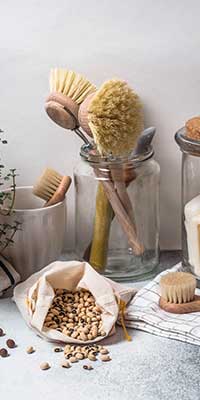 Water bottle? Check. Glass mason jars? Check. Reusable straws? Check. Like many of us, I’ve taken steps towards reducing my plastic consumption. The problem, however, remains critical, with experts predicting more plastic than fish in the sea by the year 2050. Kitchens are often the main culprits, with shelves and cupboards hoarding shameful amounts of single-use plastic – often in products, we wouldn’t expect. After reading an article over Christmas uncovering some of plastic’s crafty hiding places, I decided to find out just whereabouts in my kitchen plastic might be concealing itself, and what I can do to avoid it.
Water bottle? Check. Glass mason jars? Check. Reusable straws? Check. Like many of us, I’ve taken steps towards reducing my plastic consumption. The problem, however, remains critical, with experts predicting more plastic than fish in the sea by the year 2050. Kitchens are often the main culprits, with shelves and cupboards hoarding shameful amounts of single-use plastic – often in products, we wouldn’t expect. After reading an article over Christmas uncovering some of plastic’s crafty hiding places, I decided to find out just whereabouts in my kitchen plastic might be concealing itself, and what I can do to avoid it.
Tea bags
 Shock No. 1: my daily brew is an unexpected little offender. Not only do tea bags come wrapped in plastic packaging, they contain plastic particles themselves. Sealing around 96 per cent of tea bags is polypropylene, a reliable but non-biodegradable polymer. I was reassured by the news that some of my favourite brands have been trialling cotton stitching, corn starch or bio-plastic substitutes, yet disappointed to find that they haven’t met much success and many of my staples still depend on plastic seals. Alternatives include opting for loose leaf tea or reusable tea bags which can be disposed of safely in compost bins. I have become a lover of the loose leaves; with more variety and less environmental damage, what’s not to like?
Shock No. 1: my daily brew is an unexpected little offender. Not only do tea bags come wrapped in plastic packaging, they contain plastic particles themselves. Sealing around 96 per cent of tea bags is polypropylene, a reliable but non-biodegradable polymer. I was reassured by the news that some of my favourite brands have been trialling cotton stitching, corn starch or bio-plastic substitutes, yet disappointed to find that they haven’t met much success and many of my staples still depend on plastic seals. Alternatives include opting for loose leaf tea or reusable tea bags which can be disposed of safely in compost bins. I have become a lover of the loose leaves; with more variety and less environmental damage, what’s not to like?
 Washing-up sponges
Washing-up sponges
Just like tea bags, it isn’t just plastic packaging that is the problem here. I can rarely make one sponge outlast a week, and the only place it ends up is in my kitchen bin. Washing-up sponges also hide away harmful plastic compounds in the entirely non-biodegradable petroleum material from which they are made. What’s more, sponges destroy marine life as they break down in washing-up water and wash tiny pieces of plastic into the oceans. With seaside disaster being the price to pay for sparkling dishes, I was easily persuaded to try a range of naturally sourced scourers. For me, cellulose trumped alternatives such as hemp or coconut – its long-lasting strength, full biodegradability and low cost make it an obvious choice.
Food wrap
 Cling film is my go-to solution for keeping food fresh, and I’m not alone – 745,000 miles of the stuff is used in British kitchens each year. The ‘stretchiness’ making cling film so useful is achieved by a complex of long-lasting chemical compounds which cause fragments of plastic to linger in landfills for decades before decomposing. I thought aluminium foil was the angelic alternative, but a bit of googling soon informed me otherwise; silver foil takes around 400 years to break down. Instead, we should store leftovers in clean tubs and jam jars or try out the great range of beeswax wraps and silicone covers currently on the market. Some can be pricey, so food tubs are the way forward for me and my fridge!
Cling film is my go-to solution for keeping food fresh, and I’m not alone – 745,000 miles of the stuff is used in British kitchens each year. The ‘stretchiness’ making cling film so useful is achieved by a complex of long-lasting chemical compounds which cause fragments of plastic to linger in landfills for decades before decomposing. I thought aluminium foil was the angelic alternative, but a bit of googling soon informed me otherwise; silver foil takes around 400 years to break down. Instead, we should store leftovers in clean tubs and jam jars or try out the great range of beeswax wraps and silicone covers currently on the market. Some can be pricey, so food tubs are the way forward for me and my fridge!
With plastic pollution at a crisis point, we can all do more to cut our consumption. I’ve found that it’s worth being savvy about where plastic might be stealing itself away – and that planet-friendly alternative can always be found.
By Ellie Loxton

 Washing-up sponges
Washing-up sponges